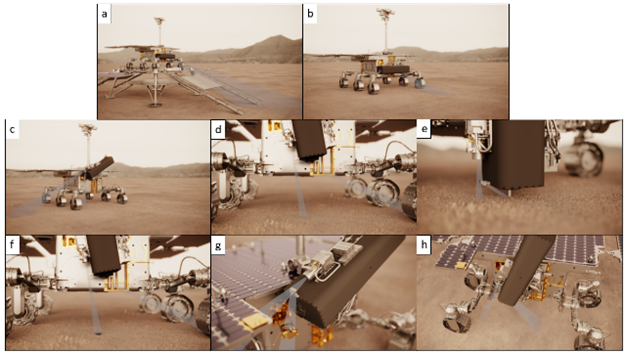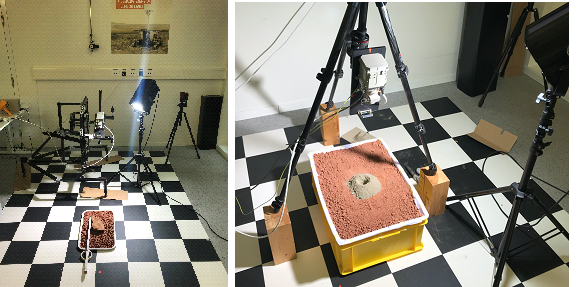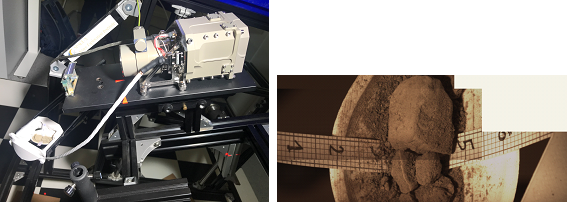CLUPI, Close-UP Imager on the ExoMars rover mission, Status and Science Operations Preparations/Simulations First Results
- 1SEI Space Exploration Institute, Neuchâtel, Switzerland
- *A full list of authors appears at the end of the abstract
CLUPI, the high-performance colour close-up imager, on board the 2020 ExoMars Rover plays an important role in attaining the mission objectives: it is the equivalent of the hand lens that no geologist is without when undertaking field work. CLUPI is a powerful, highly integrated miniaturized (<900g) low-power robust imaging system, able to sustain very low temperatures (–120°C). CLUPI has a focus mechanism allowing a working distance from 11.5cm to infinite providing outstanding pictures with a color detector of 2652x1768x3. At 11.5cm, the spatial resolution is 8 micrometer/pixel in color (Josset et al, 2017). The concept benefits from well-proven heritage: Proba-1, Rosetta, MarsExpress and Smart-1 missions…The CLUPI payload accommodation on the drill box of the rover allows to perform several key science operations configuration thanks to the two degrees of freedom movement of the drill, height and rotation. (Fig. 1).
In a typical field scenario, the geologist will use his/her eyes to make an overview of an area and the outcrops within it to determine sites of particular interest for more detailed study. In the ExoMars scenario, after having made a preliminary general evaluation, the geologist will approach a particular outcrop for closer observation of structures at the decimetre to subdecimeter scale before finally getting very close up to the surface with a hand lens (CLUPI), and/or taking a hand specimen, for detailed observation of textures and minerals. Using structural, textural and preliminary compositional analysis, the geologist identifies the materials and makes a decision as to whether they are of sufficient interest to be subsampled for laboratory analysis (using the ExoMars drill and laboratory instruments).
Given the time and energy expense necessary for drilling and analysing samples in the rover laboratory, preliminary screening of the materials to choose those most likely to be of interest is essential. ExoMars will be choosing the samples exactly as a field geologist does – by observation (backed up by years and years of field experience in rock interpretation in the field). Because the main science objective of ExoMars concerns the search for life, whose traces on Mars are likely to be cryptic, close up observation of the rocks and granular regolith will be critical to the decision as whether to drill and sample the nearby underlying materials. Thus, CLUPI is the essential final step in the choice of drill site. But not only are CLUPI’s observations of the rock outcrops important, but they also serve other purposes. CLUPI, could observe the placement of the drill head. It will also be able to observe the fines that come out of the drill hole, including any colour stratification linked to lithological changes with depth. Finally, CLUPI will provide detailed observation of the surface of the core drilled materials when they are in the sample drawer at a spatial resolution of about 17 micrometer/pixel in color. All of these investigations are summarized in the figure 1 describing the CLUPI science operational configurations.
After a brief description of these science observation configurations of CLUPI, the first promising results of the operations preparations and simulations in order to optimize the science return will be detailed. Indeed, the science operation simulations are performed by using a CLUPI flight model representative together with a drill/rover simulator, all inside a dedicated laboratory of the Space Exploration Institute based in Microcity, Neuchatel in Switzerland. The relevant results are of prime importance for the future science exploitation of CLUPI. It demonstrates the CLUPI capabilities to provide information significantly contributing to the understanding of the geological environment and could identify outstanding potential biofabrics of past life on Mars.

Figure 1: CLUPI science operational configurations. (a) On the platform, (b) geological environment survey, (c) Close-up outcrops observation, (d) drilling area observation, (e) drilling operation observation, (f) Drill hole and fines observation, (g) drilled core sample observation and (h) calibration: calibration target imaging. Images credit: ESA/SEI-TJ

Figure 2: SEI CLUPI Science Operations Laboratory based in Microcity Neuchatel. Simulations using a CLUPI flight model representative. Images Credit: Space Exploration Institute (SEI)

Figure 3: Left: CLUPI on the drill/rover simulator, sample observation configuration. Right: CLUPI output data, mosaic of three images. Images Credit: Space Exploration Institute (SEI). CLUPI Science Operations Laboratory based in Microcity Neuchatel. Simulations using a CLUPI flight model representative
J.-L. Josset, F. Westall, B. A. Hofmann, J. G. Spray, C. Cockell, S. Kempe, E. Hauber, M.C. De Sanctis, L. Colangeli, D. Koschny, T. Bontognali, E. Verrecchia, L. Diamond, M. Josset, E. Javaux, F. Esposito, M. Gunn, L. Fayon, O. Korablev, S. Erkman, G. Paar, S. Ulamec, F. Foucher, N. Kuhn, J.-P. De Vera, P. Martin, T. Josset, O. Ruesch, R. Narbey, A. Bouquety, V. Ciarletti, J. Vago
How to cite: Josset, J.-L. and the CLUPI Team: CLUPI, Close-UP Imager on the ExoMars rover mission, Status and Science Operations Preparations/Simulations First Results, Europlanet Science Congress 2022, Granada, Spain, 18–23 Sep 2022, EPSC2022-1256, https://doi.org/10.5194/epsc2022-1256, 2022.

